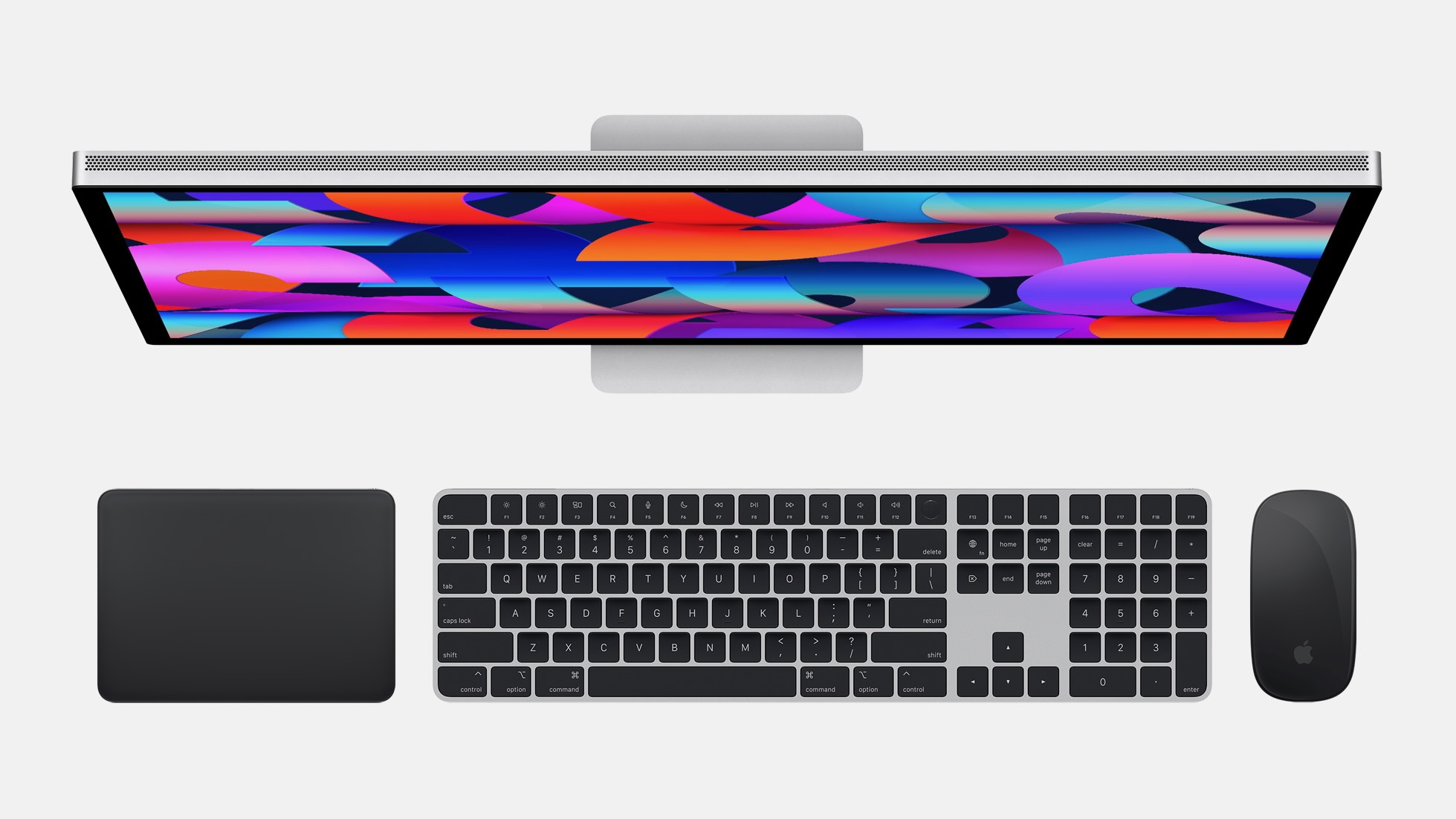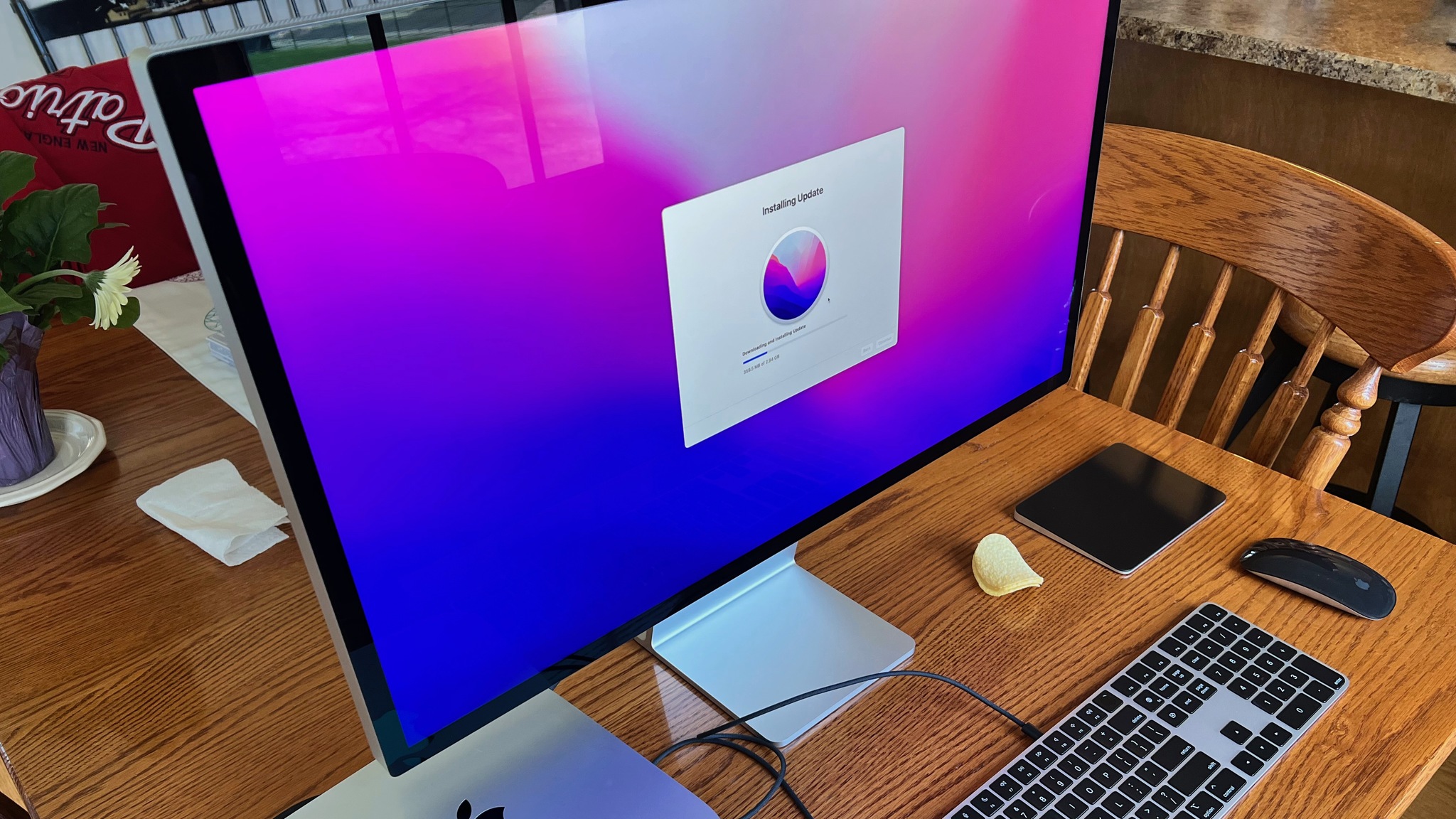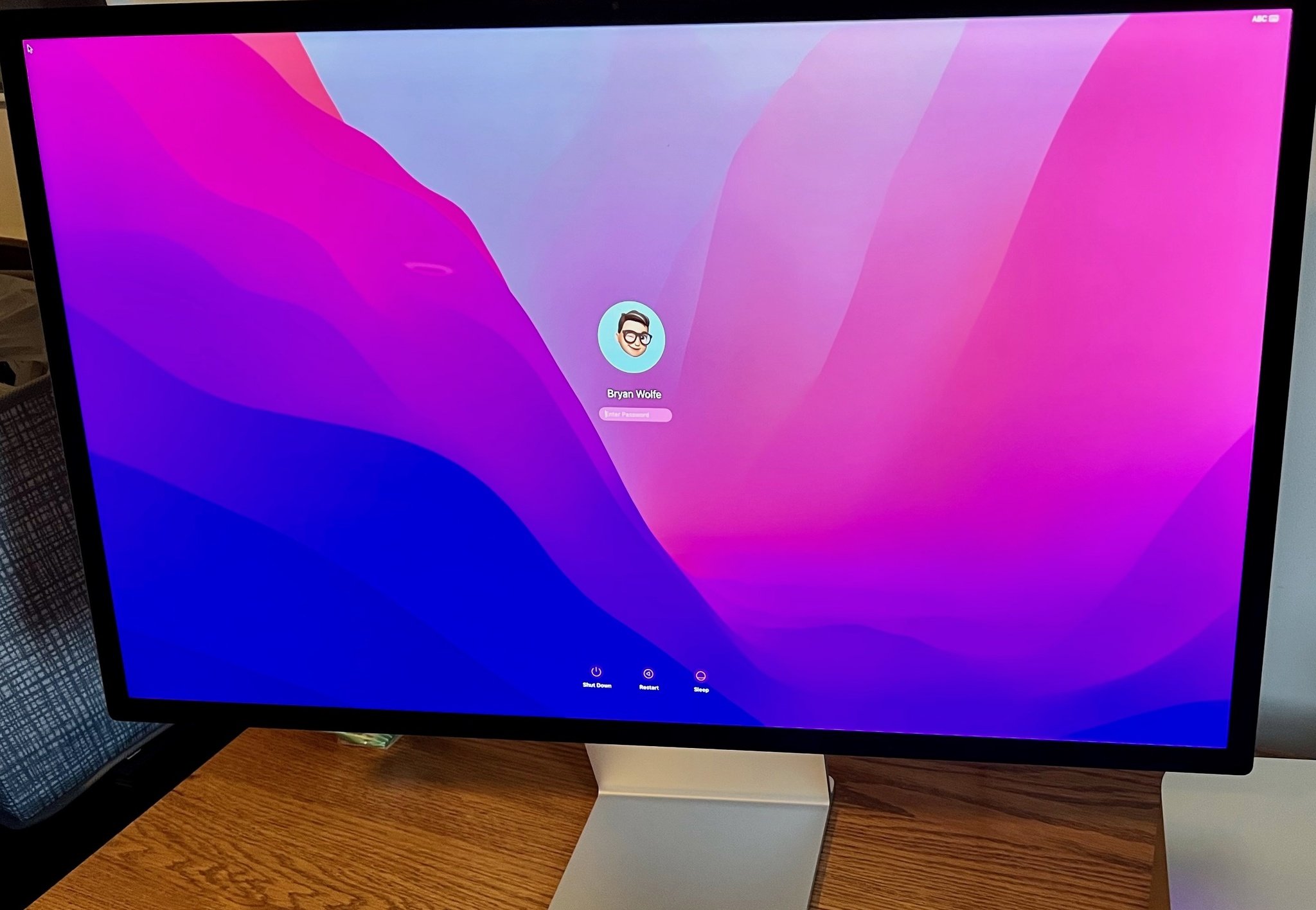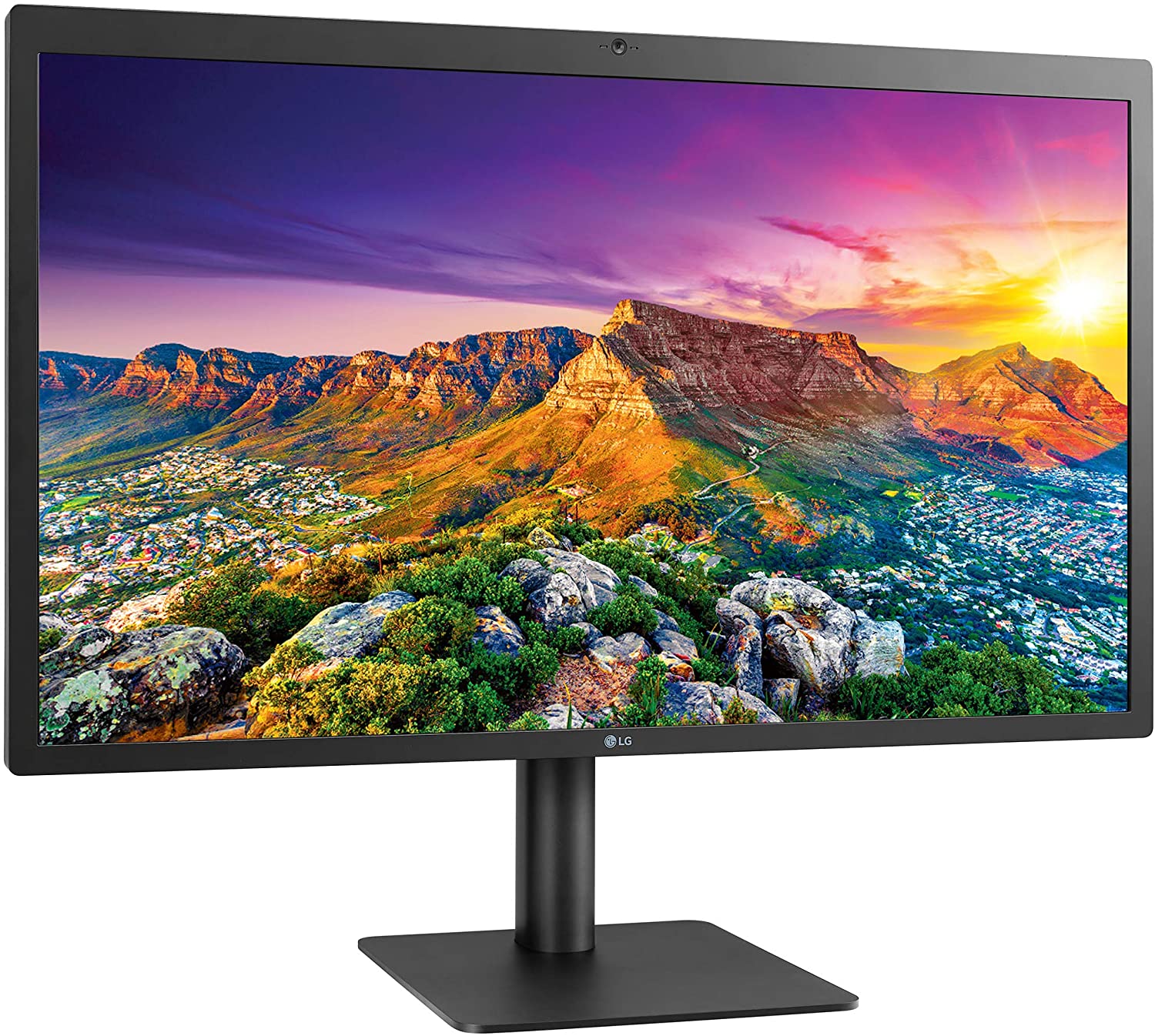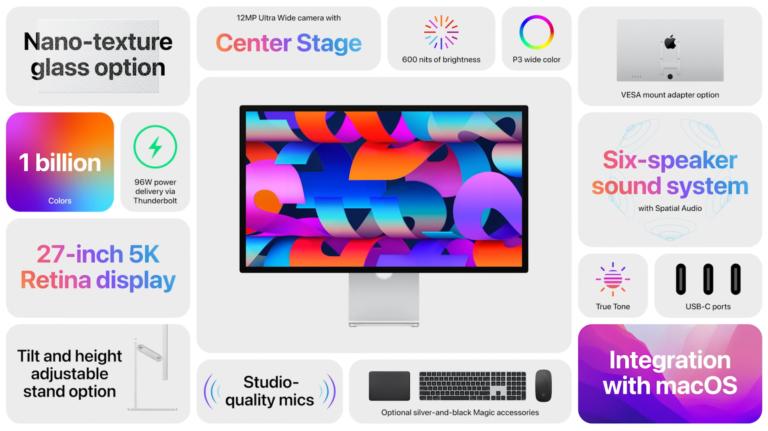Review: Apple Studio Display isn’t perfect, but offers surprising goodies
- jun
- 29
- Posted by Michael
- Posted in Okategoriserade
Most will love this 5K monitor. Others will not because it doesn't include certain features it really should.
Apple doesn't often introduce new monitors, let alone entirely new products. The Mac Studio Display arrived earlier this year as a companion to the new and well-received Mac Studio. However, it also works well with other Macs with macOS Monterey 12.3 or later. The 27-inch 5K display has a lot going for it, from its beautiful design to surprisingly strong speakers. Unfortunately, it comes with glaring omissions that will turn off some would-be buyers. Which camp is yours? It's time to find out in this Apple Studio Display review.
Apple Studio Display
Bottom line: Important drawbacks gives this display a rating much lower than perhaps we expected. However, there are plenty of reasons to consider sitting this display next to your new Mac Studio or other Mac.
The Good
- Easy installation
- Wonderful design
- Real, beneficial speakers
- Center Stage
The Bad
- Supply issues
- No HDR support
- Expensive and more so with extras
- Will you need a dongle?
From $1,599 at Apple From $1,600 at Best Buy From $1,599 at B&H Photo
Apple Studio Display: Price and availability
The entry-level Apple Studio Display comes with standard glass, a tilt-adjustable stand, or a VESA mount adapter for $1,599. Adding Nano-textured glass increases the price to $1,999, and a tilt- and height-adjustable stand adds (another) $300 to the price. The most expensive model (Nano-textured glass and a tilt- and height-adjustable stand) is $2,299. Apple, Best Buy, and other retailers are selling the Apple Studio Display. Unfortunately, continued worldwide supply issues have caused significant shipping delays, which should improve over time.
Apple Studio Display: What's good
Announced and released at the same time as the Mac Studio, Apple's new 27-inch display offers 5K with 5,120-by-2,880-pixels (218 PPI), plus a few goodies you might not have expected — all in a modern-looking design made of aluminum that one has come to expect from Apple. The unexpected extras include a 12MP Ultra-Wide camera with Center Stage, a three-mic array, and a six-speaker sound system with Spatial Audio.
The display looks gorgeous with terrific color accuracy, color gamut coverage, excellent contrast, and a respectable 600 nits brightness. In addition, the Apple Studio Display offers nine reference modes, nearly matching the 11 found on the far more expensive Apple Pro Display XDR. These modes provide calibration and fine-tuning options, which creatives will find helpful. True Tone technology is also excellent, although some will choose to remove this to get exact colors.
The display looks gorgeous with terrific color accuracy, color gamut coverage, excellent contrast, and respectable 600 nits brightness.
When Apple launched the display, early buyers saw significant issues with the product's webcam and Center Stage. The company eventually released a firmware fix to resolve image quality issues. After countless tests on my review unit, I'm happy to say Center Stage works as expected and offers a pleasant experience that was once only available on higher-end iPads. The three-mic array is also impressive, making FaceTime calls even better, even in noisy conditions.
The built-in cinema speakers also score highly — for display speakers. They provide rich sounds and work well in a pinch, but they won't replace your wireless headphones.
What about setup? All you need to do is plug your Apple Studio Display into your computer with the included Thunderbolt cable, and you're good to go. Software updates for the display happen automatically via macOS updates.
Apple Studio Display: What's not good
The Apple Studio Display comes with a few misses starting with its limited number of ports. It only has one Thunderbolt 3 (USB-C) port and three USB-C ports. Although this may be fine for some folks, others will find this limitation annoying, and it might mean adding a dongle or two to your setup. In another interesting move, the power cable on the Apple Studio Display isn't detachable, unlike the one found on the Apple Pro Display XDR. During regular usage, having an attached cable isn't a problem. However, it makes moving the nearly 14-pound display a little bit more cumbersome.
This brings us to two features the Apple Studio Display doesn't have but should: HDR and ProMotion. The former is a real headscratcher since HDR is found on iPhones, iPads, and Mac laptops. Also, the display doesn't include local dimming without HDR, which is a shame. On the latter, you're stuck with an underperforming 60Hz refresh rate, which is below the standard set by other Apple devices, including the iPhone 13 Pro series and 14-/16-inch MacBook Pro. These offer ProMotion technology for adaptive refresh rates up to 120Hz.
Additionally, although the display speakers are much better compared to those on others, it's worth noting Spatial Audio isn't always a wonderful experience here. But, again, it's why Apple (and many others) produce headphones.
What Apple's charging for the tilt- and height-adjustable stand seems excessive and like a money grab on Apple's part.
Despite the software update, the camera doesn't offer the superior image quality one would expect from a $1,600 display. So perhaps Apple's long-term solution is to convince users to take advance of the Continuity Camera that arrives later this year with macOS 13 Ventura for all the best Macs.
Finally, let's discuss the Apple Studio Display's price. My beef with the pricing is centered on what Apple's charging for the tilt- and height-adjustable stand: $400. This seems excessive and like a money grab on Apple's part. Unfortunately, it's not very surprising. The company has had a history of overcharging for extras across its product line. For years, many have complained about what Apple charges for adding wheels to the already very expensive Mac Pro. On the mobile front, iPhone owners have long voiced their displeasure with what Apple has charged for more storage, and the list continues on.
Regarding the Apple Studio Display, at least the upcharges aren't nearly as much as the ones for the XDR display. The Nano-glass is $1,000 extra versus $300 on the Apple Studio Display; a "Pro" stand also adds $1,000 in addition to the price.
Apple Studio Display: Competition
It might seem obvious that Apple Studio Display's biggest competitor is the already mentioned Apple Pro Display XDR. That wouldn't be correct, however. These are vastly different displays, with the latter being bigger and more feature-rich than the newer model at a price point that's not comparable.
Instead, I'd point you to an actual Apple Studio Display competitor: the LG 27 Inch UltraFine 5K IPS Monitor. The LG monitor is ideally suited for photo and video editing. Better still, LG designed it with the best MacBook in mind, as it features Thunderbolt 3 connectivity. Even better: it's $300 less than the entry-level Apple Studio Display. However, it doesn't have a gigantic Apple logo on its backside, which could be enough for buyers to choose Apple's display over this one.
Apple Studio Display: Should you buy it?
You should buy this if ...
- Staying in the Apple ecosystem is important
- You want Center Stage
- Can't afford the XDR but want something somewhat similar
You shouldn't buy this if...
- You're a budget shopper
- Need a bigger display than 27-inches
- Need a height-adjustable monitor and don't want to pay extra for it.
There are plenty of pros and cons to buying the Apple Studio Display. Everyday users probably won't care a lot about the key omissions as much as professionals. But, unfortunately, many daily users will care about the price, so go figure.
There's more right than wrong with the Apple Studio Display, a monitor that will wow the masses with its excellent design and fairly impressive display. Creatives might want to look elsewhere, however, as the likely necessary extras will cost even more than the already steep introductory price.
Apple Studio Display
Bottom line: Apple doesn't introduce new monitors often. Many heads get turned, especially by the most loyal Apple fans, when it does. The Apple Studio Display isn't a great product but a very good one. If you can look past its limits and really want a 27-inch 5K display, it's worth considering — if you can find one on the market to get in a reasonable time frame.
From $1,599 at Apple From $1,600 at Best Buy From $1,599 at B&H Photo
Senaste inläggen
- A new free PlayStation emulator comes to the App Store before Provenance does — and you may have heard of its developer before
- People aren’t fans of Sonos’s new app — ”Basically busted it so bad I can’t even use it”
- New lowest price for iPad Air 5 at Walmart, just as latest model is about to launch
- Apple and ChatGPT maker OpenAI one step closer to getting the chatbot on iPhone
- Han ska över efter Tim Cook
Senaste kommentarer
Arkiv
- maj 2024
- april 2024
- mars 2024
- februari 2024
- januari 2024
- december 2023
- november 2023
- oktober 2023
- september 2023
- augusti 2023
- juli 2023
- juni 2023
- maj 2023
- april 2023
- mars 2023
- februari 2023
- januari 2023
- december 2022
- november 2022
- oktober 2022
- september 2022
- augusti 2022
- juli 2022
- juni 2022
- maj 2022
- april 2022
- mars 2022
- februari 2022
- april 2021
- mars 2021
- januari 2021
- december 2020
- november 2020
- oktober 2020
- september 2020
- augusti 2020
- juli 2020
- juni 2020
- maj 2020
- april 2020
- mars 2020
- februari 2020
- januari 2020
- december 2019
- november 2019
- oktober 2019
- september 2019
- augusti 2019
- juli 2019
- juni 2019
- maj 2019
- april 2019
- mars 2019
- februari 2019
- januari 2019
- december 2018
- november 2018
- oktober 2018
- september 2018
- augusti 2018
- juli 2018
- juni 2018
- maj 2018
- april 2018
- mars 2018
- februari 2018
- januari 2018
- december 2017
- november 2017
- oktober 2017
- september 2017
- augusti 2017
- juli 2017
- juni 2017
- maj 2017
- april 2017
- mars 2017
- februari 2017
- januari 2017
- december 2016
- november 2016
- oktober 2016
- september 2016
- augusti 2016
- juli 2016
- juni 2016
- maj 2016
- april 2016
- mars 2016
- februari 2016
- januari 2016
- december 2015
- november 2015
- oktober 2015
- september 2015
- augusti 2015
- juli 2015
- juni 2015
- maj 2015
- april 2015
- mars 2015
- februari 2015
- januari 2015
- december 2014
- november 2014
- oktober 2014
- september 2014
- augusti 2014
- juli 2014
- juni 2014
- maj 2014
- april 2014
- mars 2014
- februari 2014
- januari 2014
Kategorier
- –> Publicera på PFA löp
- (PRODUCT) RED
- 2015
- 25PP
- 2nd gen
- 32gb
- 3D Touch
- 3D-kamera
- 4k
- 64gb
- 9to5mac
- A10
- A9X
- Aaron Sorkin
- Accessories
- adapter
- AirPlay
- AirPods
- Aktiv
- Aktivitetsarmband
- Aktuellt
- Alfred
- AMOLED
- Android Wear
- Angela Ahrendts
- Ångerätt
- announcements
- Ansiktsigenkänning
- app
- App Store
- Appar
- Apple
- Apple Beta Software Program
- Apple Book
- Apple CarPlay
- Apple Event
- Apple iMac
- Apple Mac Mini
- Apple Macbook
- Apple MacBook Air
- Apple MacBook Pro
- Apple Macos
- Apple Maps
- Apple Music
- Apple Music Festival
- Apple Music Radio
- Apple Offer
- Apple Online Store
- Apple Park
- Apple Pay
- Apple Pencil
- Apple Podcast
- Apple Store
- Apple Store 3.3
- Apple TV
- apple tv 4
- Apple TV 4K
- Apple Watch
- Apple Watch 2
- Apple Watch 8
- Apple Watch 9
- Apple Watch Apps
- Apple Watch SE
- Apple Watch Series 2
- Apple Watch Sport
- Apple Watch Ultra
- AppleCare
- AppleTV
- Application
- Applications
- Apps
- AppStore
- Apptillägg
- Apptips
- AppTV
- April
- Arbetsminne
- armband
- Art Apps
- Återköp
- återvinning
- Åtgärdsalternativ
- atvflash
- Audio Apps
- Augmented REality
- Back-to-school
- Bakgrundsbilder
- BankId
- Barn
- Batteri
- batteriskal
- batteritid
- Beats
- Beats 1
- Beats Solo 2 Wireless
- Beats Solo2
- Bebis
- Beginner Tips
- Belkin
- Bendgate
- beta
- Beta 3
- betaversion
- betaversioner
- bilddagboken.se
- bilder
- bilhållare
- billboard
- Bioteknik
- Blendtec
- Bloomberg
- Bloons TD 5
- Bluelounge
- Bluetooth
- Böj
- Booking.com
- Borderlinx
- bose
- bugg
- Buggar
- Buggfixar
- Butik
- C More
- Calc 2M
- Camera
- Campus 2
- Canal Digital
- Carpool Karaoke
- Caseual
- Catalyst
- CES 2015
- Chassit
- Chip
- Chrome Remote Desktop
- Chromecast
- citrix
- clic 360
- CNBC
- Connect
- Cydia
- Dagens app
- Dagens tips
- Damm
- Danny Boyle
- Data
- datamängd
- Datorer
- Datortillbehör
- Datum
- Defense
- Dekaler
- Designed by Apple in California
- Developer
- Development
- Digital Inn
- Digital Touch
- Digitalbox
- DigiTimes
- Direkt
- Discover
- display
- DisplayMate
- Dive
- Docka
- Dräger 3000
- Dropbox
- Droples
- DxOMark
- E-post
- earpod
- EarPods
- Earth Day
- Eddie Cue
- eddy cue
- Educational Apps
- Ekonomi
- Ekonomi/Bransch
- El Capitan
- Elements
- ElevationLab
- Elgato Eve
- Elgato Eve Energy
- EM 2016
- Emoji
- emojis
- emoticons
- Enligt
- EU
- event
- Eventrykten
- EverythingApplePro
- Faceshift
- facetime
- Fäste
- Featured
- Features
- Feng
- Film / Tv-serier
- Filmer
- Filstorlek
- Finance Apps
- Finder For AirPods
- Finland
- FireCore
- Fitbit
- Fitness Accessories
- Fjärrstyr
- Flurry
- Födelsedag
- fodral
- Förboka
- Force Touch
- förhandsboka
- Första intryck
- Forumtipset
- foto
- FoU (Forskning och Utveckling)
- Fource Touch
- Foxconn
- FPS Games
- Framtid
- Fre Power
- Frontpage
- Fullt
- Fuse Chicken
- Fyra
- Gadgets
- Gagatsvart
- Gamereactor
- Games
- Gaming
- Gaming Chairs
- Gästkrönika
- General
- Gigaset
- Gitarr
- Glas
- GM
- Google Maps
- Google Now
- gratis
- grattis
- Guide
- Guider
- Guider & listor
- Guld
- hack
- Halebop
- hållare
- Hälsa
- Hårdvara
- HBO
- HBO Nordic
- Health
- Health and Fitness
- Health and Fitness Apps
- Hej Siri
- Helvetica Neue
- Hemelektronik
- Hemknapp
- Hemlarm
- Hermes
- Hitta min iphone
- Hjärta
- högtalare
- HomeKit
- HomePod
- hörlurar
- htc
- Hue
- Humor
- i
- I Am A Witness
- IBM
- iBolt
- iBomber
- iBook
- icar
- iCloud
- iCloud Drive
- iCloud Voicemail
- iCloud.com
- iDevices
- IDG Play
- idownloadblog
- iFixit
- ikea
- iKörkort
- iLife
- Illusion Labs
- iMac
- IMAP
- iMessage
- iMessages
- iMore Show
- Incipio
- InFuse
- Inspelning
- Instagram-flöde
- Instrument
- Intel
- Internet/Webbtjänster
- iOS
- iOS 10
- iOS 12
- iOS 17
- iOS 18
- iOS 5
- iOS 7
- iOS 8
- iOS 8 beta
- iOS 8.1.3
- iOS 8.2
- iOS 8.3
- iOS 8.4
- iOS 8.4.1
- iOS 9
- iOS 9 beta 4
- iOS 9.1
- iOS 9.1 beta 2
- iOS 9.2
- iOS 9.2.1
- iOS 9.3
- IOS Games
- ios uppdatering
- ios9
- iPad
- iPad Accessories
- iPad Air
- iPad Air 2
- iPad Air 3
- iPad Air 5
- iPad Apps
- iPad Mini
- iPad mini 4
- iPad Mini 6
- iPad mini retina
- iPad Pro
- iPados
- iphone
- iPhone 12
- iPhone 14
- iPhone 14 Pro
- iPhone 15
- iPhone 16
- iPhone 17
- iPhone 5
- iPhone 5S
- iPhone 5se
- iPhone 6
- iphone 6 plus
- iPhone 6c
- iPhone 6s
- iPhone 6S plus
- iPhone 7
- iPhone 7 display
- iPhone 7 Plus
- iPhone 7s
- iPhone Accessories
- iPhone Apps
- iPhone SE
- iphone x
- iPhone XS
- iPhone XS Max
- iPhone7
- iPhoneGuiden
- iPhoneguiden.se
- iPhones
- iPod
- iPod Nano
- iPod shuffle
- ipod touch
- iSight
- iTunes
- iWatch
- iWork
- iWork för iCloud beta
- Jailbreak
- James Corden
- Jämförande test
- Jämförelse
- Jet Black
- Jet White
- Jönssonligan
- Jony Ive
- Juice Pack
- Juridik
- Just mobile
- kalender
- kalkylator
- Kamera
- Kameratest
- Karriär/Utbildning
- Kartor
- Kevin Hart
- keynote
- Keynote 2016
- KGI
- KGI Security
- Kina
- Klassiskt läderspänne
- Kod
- Kollage
- koncept
- konceptbilder
- köpguide
- krasch
- Krascha iPhone
- Krönika
- Kvartalsrapport
- Laddhållare
- laddningsdocka
- Laddunderlägg
- läderloop
- lagar
- Lagring
- Lajka
- Länder
- lansering
- laserfokus
- Layout
- leather loop
- LG
- Liam
- Lifeproof
- Lightnigport
- lightning
- Linux
- LinX
- live
- Live GIF
- Live Photos
- Live-event
- Livsstil
- Ljud & Bild
- Logitech
- LOL
- Lösenkod
- Lösenkodlås
- Lovande spel
- LTE
- Luxe Edition
- M3
- M3TV
- Mac
- Mac App Store
- Mac Apps
- Mac Mini
- Mac OS
- Mac OS X
- Mac OS X (generellt)
- Mac OS X Snow Leopard
- Mac Pro
- Macbook
- Macbook Air
- Macbook Pro
- Macforum
- Macintosh
- macOS
- Macs
- MacWorld
- Made for Apple Watch
- magi
- Magic
- MagSafe
- Martin Hajek
- matematik
- Meddelanden
- Media Markt
- Medieproduktion
- Mediocre
- Messaging Apps
- Messenger
- MetaWatch
- Mfi
- Michael Fassbender
- microsoft
- Mikrofon
- Minecraft
- Ming-Chi Kuo
- miniräknare
- minne
- Mixer
- Mixning
- Mjukvara
- mobbning
- Mobile Content
- Mobilt
- Mobilt/Handdator/Laptop
- Mobiltelefon
- Mockup
- Mophie
- mors dag
- moto 360
- Motor
- MTV VMA
- multitasking
- Music
- Music Apps
- Music, Movies and TV
- Musik
- Musikmemon
- MW Expo 2008
- native union
- Nätverk
- Navigation Apps
- nedgradera
- Netatmo Welcome
- Netflix
- Netgear Arlo
- News
- Niantic
- Nike
- Nikkei
- Nintendo
- Nöje
- Norge
- Notis
- Notiscenter
- nya färger
- Nyfödd
- Nyheter
- Officeprogram
- Okategoriserade
- OLED
- omdöme
- Omsättning
- OS X
- OS X El Capitan
- OS X Mavericks
- OS X Yosemite
- Outlook
- Övrig mjukvara
- Övrigt
- PanGu
- papper
- patent
- PC
- pebble
- Pebble Smartwatch
- Pebble Steel
- Pebble Time
- Pebble Time Steel
- Persondatorer
- Petter Hegevall
- PewDiePie
- Philips
- Philips Hue
- Phones
- Photoshop
- Planet of the apps
- Plex
- Pluggar
- Plus
- Plusbox
- Podcast
- Podcast Apps
- Pokemon
- Pokemon Go
- Policy
- Porträttläge
- PP
- Pris
- priser
- problem
- Problems
- Productivity Apps
- Program
- Prylar & tillbehör
- Publik
- publik beta
- QuickTime
- räkenskapsår
- räkna
- ram
- RAM-minne
- Rapport/Undersökning/Trend
- Rea
- Reading Apps
- recension
- Red
- reklaamfilm
- reklam
- reklamfilm
- reklamfilmer
- rekord
- Rendering
- reparation
- Reportage
- Reptest
- ResearchKit
- Retro
- Review
- Ring
- Ringa
- Rocket Cars
- Rosa
- Rumors
- Rumours
- RunKeeper
- rykte
- Rykten
- Safir
- Säkerhet
- Säkerhetsbrist
- Samhälle/Politik
- samsung
- Samtal
- San Francisco
- SAP
- security
- Series 2
- Servrar
- Shigeru Miyamoto
- Sia
- Siri
- SJ Min resa
- skal
- Skal iPhone 6
- skal iPhone 6s
- skärm
- SKärmdump
- Skärmglas
- Skribent
- skribenter medarbetare
- Skriva ut
- skruvmejsel
- skydd
- Skyddsfilm
- Skype
- slice intelligence
- Smart
- smart hem
- Smart Home
- Smart Keyboard
- Smart klocka
- Smart Lights
- smartphone
- Smartwatch
- Snabbt
- Snapchat
- Social Apps
- Software
- Solo2
- sommar
- Sonos
- Sony
- soundtouch
- Space Marshals
- spår
- Speakers
- Special Event
- Spel
- Spelkonsol
- Spellistor
- Split Screen
- Split View
- Sport
- Sportband
- Sports Apps
- spotify
- Spring forward
- Statistik
- Steve Jobs
- Stickers
- Stockholm
- Stor iPhone
- Storlek
- Story Mode
- Strategy Games
- streama
- Streaming
- stresstest
- Ström
- Studentrabatt
- stylus
- Super Mario Run
- support
- Surf
- Surfplatta
- svenska
- sverige
- Sverigelansering
- Switch
- Systemstatus
- Systemutveckling
- tåg
- Taig
- Tangentbord
- Taptic Engine
- Tårta
- tät
- Tävling
- Taylor Swift
- Teknik
- tele 2
- Telefoner
- Telekom
- Telia
- Test
- Tid
- TikTok
- Tile
- tillbehör
- Tim Cook
- TIME
- TimeStand
- Tiny Umbrella
- Tips
- Toppnyhet IDG.se
- Touch ID
- TouchID
- tower defence
- trådlös laddning
- Trådlösa hörlurar
- trådlöst
- trailer
- Travel Apps
- Tre
- TrendForce
- TripAdvisor
- Trolleri
- trump
- TSMC
- Tum
- tv
- tvätta
- tvOS
- tvOS 9.2
- tvOS beta 2
- Tweak
- Typsnitt
- Ubytesprogram
- UE MegaBoom
- Unboxing
- Underhållning/Spel
- unidays
- United Daily News
- Unix
- Updates
- Uppdatera
- uppdatering
- Upplösning
- upptäckt
- USA
- Ut på Twitter
- utbyte
- utbytesprogram
- Utilities Apps
- Utlottning
- utrymme
- utvecklare
- varumärke
- Vatten
- Vattentålig
- vattentät
- vävt nylon
- Verktyg
- Viaplay
- Vibrator
- video
- Videoartiklar och webb-tv (M3/TW/CS)
- Villkor
- viloknapp
- Virtual Reality
- Virus
- visa
- Vision Pro
- VLC
- Volvo on call
- W1
- Waitrose
- Watch OS
- WatchOS
- WatchOS 2
- watchOS 2.0.1
- watchOS 2.2
- Webbtv (AppTV)
- wi-fi
- Wifi-samtal
- Windows
- Windows 8
- WWDC
- WWDC2015
- yalu
- Youtube
- Zlatan



